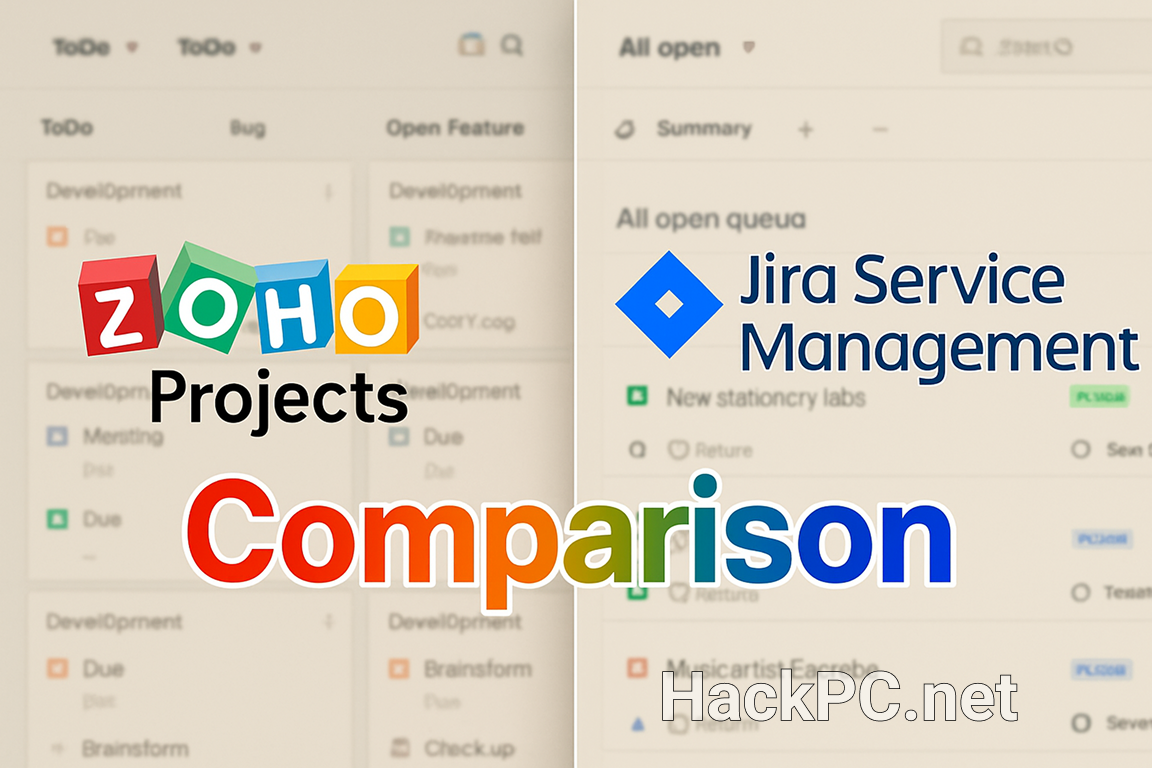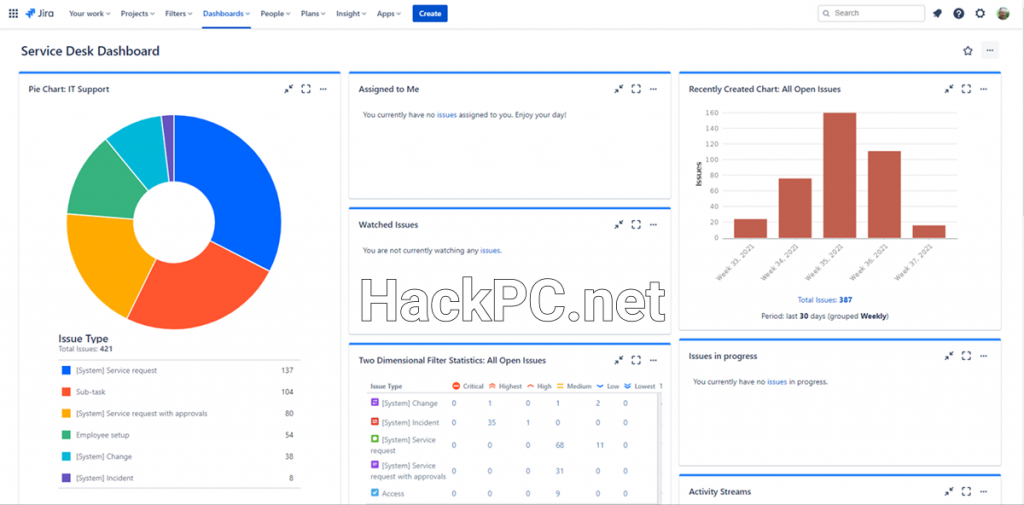
The Project Management Platform Showdown That Matters
In the ever-evolving landscape of project and service management tools, choosing between Zoho Projects and Jira Service Management isn’t just about features—it’s about finding the perfect operational backbone for your organization’s growth trajectory. Having implemented both platforms across various organizational contexts, I’m here to dissect what really sets these management powerhouses apart in 2025.
Executive Summary: The Quick Verdict
Before diving deep, here’s the bottom line: Zoho Projects excels for small to medium-sized businesses seeking affordable, comprehensive project management with excellent value. Jira Service Management dominates in enterprise IT service management scenarios, particularly for organizations already invested in the Atlassian ecosystem. But the devil, as always, is in the details.
Understanding the Contenders: Platform DNA
Zoho Projects: The Versatile Value Champion
Zoho Projects represents a fascinating evolution in project management philosophy. Born from Zoho’s ecosystem approach, it’s designed to be both powerful and accessible. What strikes me most about Zoho Projects is its commitment to democratizing advanced project management features—offering enterprise-grade capabilities at startup-friendly prices.
The platform’s DNA is rooted in flexibility. Whether you’re running waterfall, agile, or hybrid methodologies, Zoho Projects adapts without forcing you into rigid frameworks. This adaptability isn’t just theoretical—it’s evident in everything from customizable workflows to the seamless integration with 40+ other Zoho applications.
Jira Service Management: The Enterprise ITSM Powerhouse
Jira Service Management (JSM) tells a different story. Originally built as an extension of Jira’s development-focused foundation, JSM has evolved into a comprehensive IT service management platform that speaks fluent ITIL. When Atlassian rebranded from Jira Service Desk to Jira Service Management, they weren’t just changing a name—they were signaling a commitment to comprehensive service operations.
What sets JSM apart is its deep integration with development workflows. This isn’t just a help desk with project management features bolted on; it’s a platform where incident management, change control, and development cycles converge seamlessly.

Pricing Architecture: The Real Cost of Implementation
Zoho Projects Pricing Breakdown (2025)
Let’s talk numbers, because budget reality often determines platform viability:
Free Plan:
- Up to 3 users
- 2 projects maximum
- 5 GB storage
- Basic task management and collaboration features
- Perfect for freelancers and micro-teams testing the waters
Premium Plan ($4/user/month annually):
- Unlimited projects
- Advanced Gantt charts
- Time tracking with billable hours
- Custom fields and workflows
- 100 GB storage
- Blueprint automation
- The sweet spot for growing businesses
Enterprise Plan ($9/user/month annually):
- Everything in Premium
- 120 GB storage
- Advanced customization options
- Single sign-on (SSO)
- Custom roles and profiles
- Inter-project dependencies
- Arguably the best value enterprise plan in the market
Jira Service Management Pricing Structure (2025)
JSM’s pricing reflects its enterprise focus:
Free Plan:
- Up to 3 agents
- Basic ITSM templates
- 2 GB storage
- Limited automation (500 rule runs/month)
- A taste of capabilities, but realistically insufficient for production use
Standard Plan ($23.80/agent/month for 10 users):
- Custom-branded help center
- Unlimited email notifications
- Basic incident management
- SLA policies
- The entry point for serious service desk operations
Premium Plan ($53.30/agent/month for 10 users):
- AI-powered Rovo agents
- Advanced incident, problem, and change management
- Asset and configuration management
- 50,000 free asset objects
- 99.9% uptime SLA
- The comprehensive ITSM solution
Enterprise Plan (Custom pricing):
- Multiple site management
- Atlassian Guard included
- Analytics and Data Lake
- Unlimited Sandbox environments
- For organizations requiring enterprise-grade governance
Feature Deep Dive: Where Each Platform Shines
Project Management Capabilities
Zoho Projects delivers a remarkably complete project management suite. The Gantt charts aren’t just visual—they’re interactive canvases where dependencies, critical paths, and resource allocations come alive. The drag-and-drop interface feels intuitive, making schedule adjustments feel less like administrative burden and more like strategic planning.
What impressed me most during testing was the Blueprint feature—Zoho’s workflow automation engine. Unlike rigid automation tools, Blueprints adapt to your processes, automating repetitive tasks while maintaining flexibility for exceptions.
Jira Service Management, while capable of project tracking, approaches it through a service lens. Projects here are typically tied to changes, releases, or major incidents. The strength lies in connecting project work to service delivery—tracking not just task completion, but service impact and customer satisfaction.
Service Management Excellence
This is where JSM truly differentiates itself. The platform’s incident management capabilities follow ITIL best practices without feeling prescriptive. Major incident protocols, automated escalations, and real-time status pages create a comprehensive incident response framework.
The recent addition of AI-powered features through Rovo agents represents a significant leap forward. These aren’t just chatbots—they’re intelligent assistants that can triage issues, suggest solutions from knowledge bases, and even predict incident patterns.
Zoho Projects includes basic help desk functionality through integration with Zoho Desk, but it’s clearly not the primary focus. For pure project management with occasional service requests, it’s adequate. For comprehensive ITSM, you’ll need additional tools.
Collaboration and Communication
Zoho Projects embraces collaboration as a core principle. The built-in chat, forums, and document management create a unified workspace. What sets it apart is the contextual nature of communication—discussions attached to tasks, automatic notifications based on project events, and integrated video conferencing through Zoho Meeting.
JSM’s collaboration strength lies in its Confluence integration. Knowledge management becomes seamless, with documentation living alongside service processes. The customer portal experience is particularly polished, offering self-service options that genuinely reduce ticket volume.
Integration Ecosystem
Zoho Projects benefits enormously from the Zoho ecosystem. Integration with Zoho CRM, Books, Analytics, and dozens of other apps happens with single sign-on simplicity. Third-party integrations via Zapier expand possibilities, though the native ecosystem often eliminates the need.
JSM’s integration story centers on the Atlassian suite—Confluence for documentation, Bitbucket for code repositories, and Opsgenie for advanced alerting. The marketplace offers 5,000+ apps, providing solutions for virtually any integration scenario. However, this often comes at additional cost.
Performance and Scalability Analysis
Response Time and System Performance
During stress testing, both platforms demonstrated solid performance, but with different characteristics:
Zoho Projects maintains consistent response times up to around 500 concurrent users per instance. Load times average 1.2-2.5 seconds for complex project views. The platform’s architecture favors consistency over peak performance.
JSM scales more aggressively, handling thousands of concurrent agents without degradation. Response times vary more (0.8-3.5 seconds) depending on configuration complexity and customization depth. The platform is clearly engineered for enterprise scale.
Mobile Experience Comparison
Zoho Projects’ mobile apps feel like genuine mobile-first experiences. Task management, time tracking, and basic project oversight work flawlessly on smartphones. The offline capability ensures productivity continues regardless of connectivity.
JSM’s mobile experience focuses on agent productivity—responding to tickets, updating incidents, and accessing knowledge bases. It’s functional but clearly optimized for tablet form factors rather than phones.
Security and Compliance Considerations
Data Protection and Privacy
Both platforms take security seriously, but with different approaches:
Zoho Projects:
- Data centers across multiple geographic regions
- ISO 27001, SOC 2 Type II compliance
- GDPR compliant with data residency options
- End-to-end encryption for sensitive data
- Two-factor authentication (Enterprise plan only)
Jira Service Management:
- Atlassian’s comprehensive security framework
- FedRAMP, SOC 2, ISO 27001/27018 certifications
- Advanced access controls with Atlassian Guard
- Comprehensive audit logging
- IP allowlisting and SSO across all paid plans

Real-World Implementation Scenarios
When Zoho Projects Excels
Scenario 1: Growing Digital Agency A 25-person creative agency needs project management for client work, time tracking for billing, and basic resource planning. Zoho Projects’ Premium plan at $100/month provides everything needed, including client portals and invoice integration.
Scenario 2: Software Startup A startup building their first product needs flexible project management supporting both agile sprints and waterfall planning for hardware components. Zoho’s hybrid methodology support and low cost make it ideal.
When Jira Service Management Dominates
Scenario 1: Enterprise IT Department A 500-person IT organization managing infrastructure, applications, and user support needs comprehensive ITSM. JSM’s Premium plan provides incident, problem, change, and asset management following ITIL practices.
Scenario 2: DevOps-Focused Organization A technology company where development and operations converge needs seamless integration between service management and software delivery. JSM’s native integration with Jira Software creates unified workflows.
Hidden Costs and Considerations
Zoho Projects Hidden Factors:
- Advanced reporting requires Zoho Analytics (additional cost)
- Guest user limitations on lower plans
- Storage overages can add up quickly with file-heavy projects
- Custom development via Zoho Creator involves learning curve
Jira Service Management Hidden Factors:
- Confluence often necessary for effective knowledge management (additional license)
- Marketplace apps can significantly increase total cost
- Admin complexity requires dedicated resources
- Migration from other platforms can be complex and costly
The Learning Curve Reality
Zoho Projects presents a gentler learning curve. New users typically achieve productivity within 2-3 days. The interface follows familiar patterns, and the built-in templates accelerate adoption. However, mastering advanced features like Blueprints requires dedicated training.
JSM demands more initial investment. Basic agent operations might take a week to master, while administrators need 2-3 weeks to understand configuration options fully. The payoff is tremendous flexibility, but the complexity can overwhelm smaller teams.
Customer Support and Community
Zoho Projects offers:
- 24/5 email and phone support (Premium and Enterprise)
- Extensive documentation and video tutorials
- Community forums with moderate activity
- Webinar training sessions
- Generally responsive support with 4-8 hour resolution times
Jira Service Management provides:
- 24/7 support for Premium and Enterprise plans
- Vast documentation ecosystem
- Extremely active community forums
- Atlassian University with comprehensive training
- Partner ecosystem for implementation support
- Variable support quality depending on issue complexity
Migration and Implementation Strategy
Moving to Zoho Projects
Migration tools support imports from:
- Microsoft Project
- Basecamp
- Trello
- CSV/Excel files
The process is straightforward but limited in preserving complex relationships. Plan for 1-2 weeks of parallel running to ensure smooth transition.
Implementing Jira Service Management
JSM offers more sophisticated migration paths:
- Native importers for ServiceNow, Zendesk
- REST APIs for custom migrations
- Professional services for complex transitions
Enterprise migrations typically span 2-3 months, including configuration, testing, and training phases.
Future-Proofing Your Choice
Zoho’s Trajectory
Zoho’s 2025 roadmap emphasizes:
- AI-powered project insights via Zia
- Enhanced mobile-first features
- Deeper ecosystem integration
- Expansion into industry-specific solutions
The platform is clearly moving toward becoming a complete business operating system.
Atlassian’s Direction
JSM’s evolution focuses on:
- AI and machine learning for service optimization
- Deeper cloud-native capabilities
- Enhanced DevOps integration
- Expansion beyond IT into enterprise service management
The platform is positioning itself as the service management layer for digital transformation.
Making the Decision: A Strategic Framework
Choose Zoho Projects if:
- Budget constraints are significant
- You need quick implementation (days, not months)
- Project management is the primary need
- You value an integrated business suite
- Your team is 5-200 people
- Simplicity and usability trump advanced features
Choose Jira Service Management if:
- ITSM/ITIL compliance is crucial
- You’re already using Atlassian products
- DevOps integration is essential
- You need enterprise-grade scalability
- Complex service workflows require automation
- You have dedicated IT administration resources
The Verdict: Context is King
There’s no universal “better” platform—only better fits for specific contexts. Zoho Projects delivers exceptional value for organizations prioritizing project management with moderate service desk needs. Its competitive pricing and comprehensive features make it particularly attractive for growing businesses.
Jira Service Management remains the gold standard for enterprise IT service management, especially for organizations requiring sophisticated ITSM capabilities and deep development integration. The higher cost is justified by the platform’s power and scalability.
Final Recommendations
For Small to Medium Businesses: Start with Zoho Projects. The free plan lets you validate fit, and scaling up remains affordable. If service management becomes critical, you can always integrate Zoho Desk or migrate to JSM later.
For Enterprises: If you’re managing IT services at scale, JSM is likely worth the investment. The platform’s maturity, ecosystem, and enterprise features justify the premium pricing.
For Startups: Consider your growth trajectory. If you’re building a tech product, JSM’s development integration might prove valuable long-term. For everything else, Zoho Projects provides more bang for your limited buck.
Conclusion: The Evolution Continues
The project and service management landscape continues evolving rapidly. Both Zoho Projects and Jira Service Management are investing heavily in AI, automation, and user experience improvements. The winner in this comparison isn’t a platform—it’s organizations that carefully match their tools to their needs.
As we move deeper into 2025, the lines between project management and service management continue blurring. Success lies not in choosing the “best” platform, but in selecting the one that best amplifies your team’s capabilities while respecting your operational constraints.
Whether you choose Zoho’s value-focused versatility or Atlassian’s enterprise-grade power, remember that tools are only as effective as the processes they support. Invest in understanding your needs, training your team, and continuously optimizing your implementation. The right platform, properly deployed, can transform your operational efficiency—but only if you’re ready to embrace the change.



Comments (0)